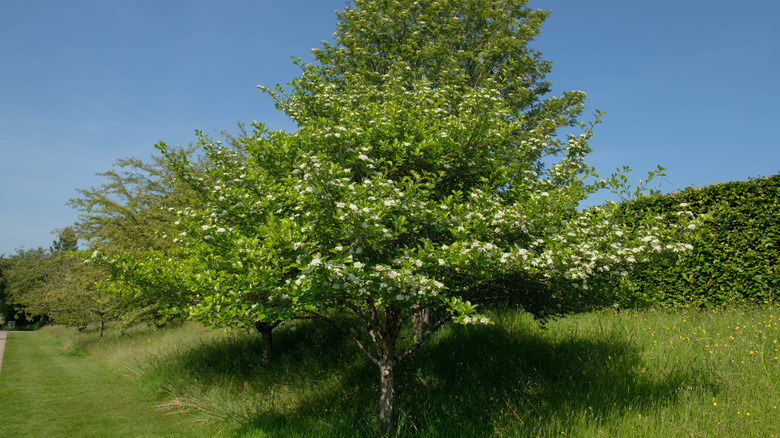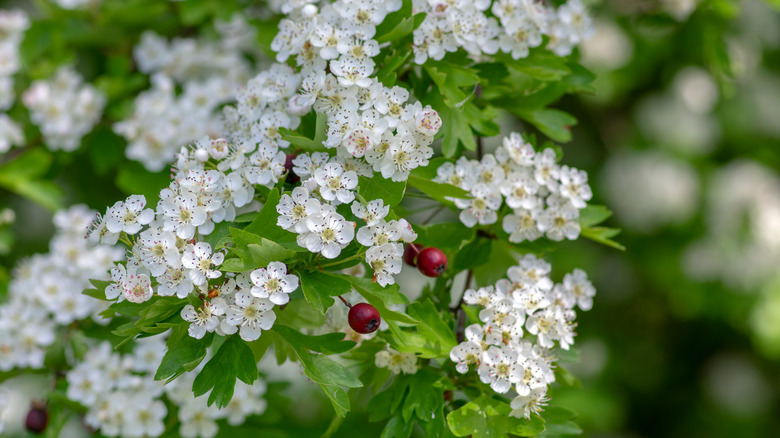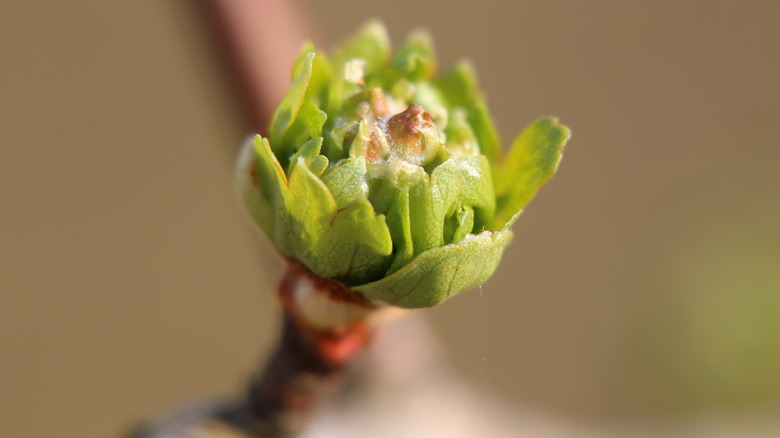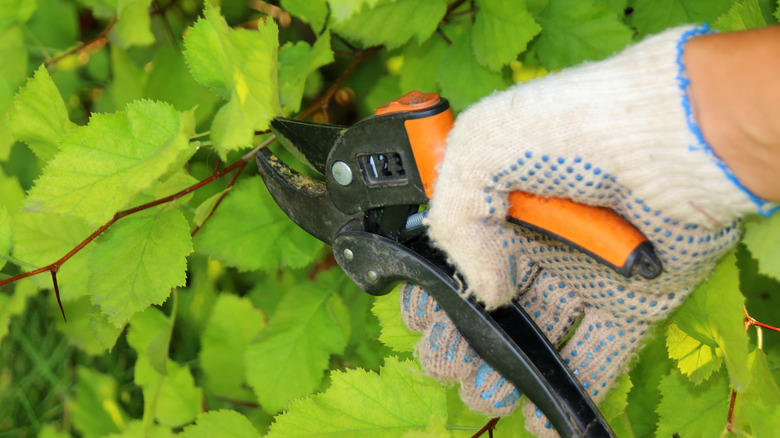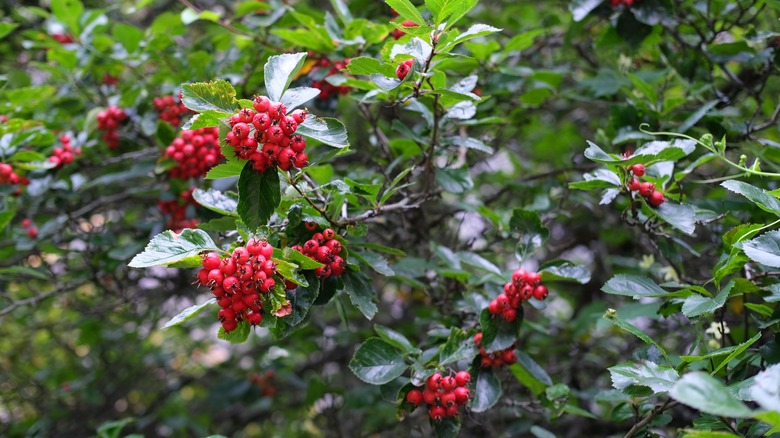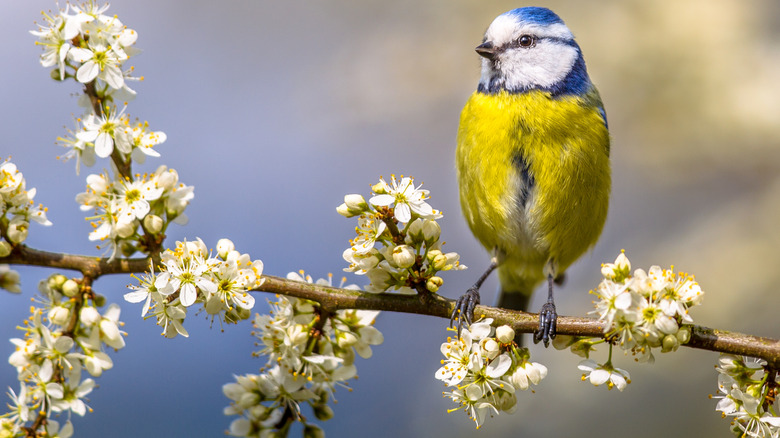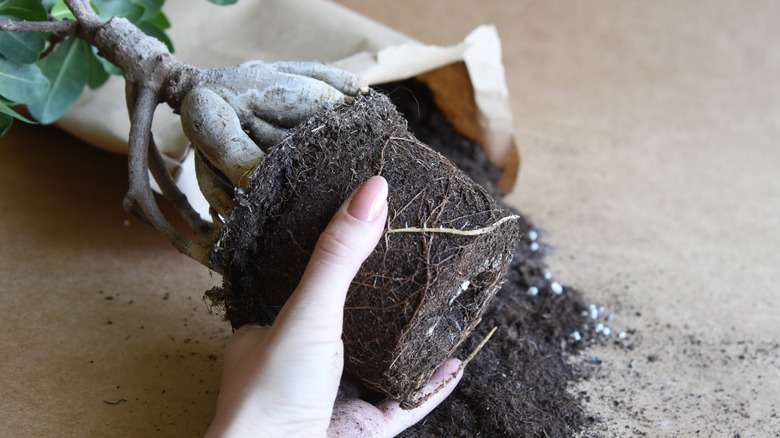How To Grow And Care For A Hawthorn Tree
The hawthorn tree is a flowering deciduous that is well-loved for its tolerant and hardy nature. It doesn't come as a surprise that it has become popular in both residential and commercial landscapes. According to Garden Guides, the hawthorn tree belongs to the genus Crataegus and is native to regions with a temperate climate, such as North Africa and the Mediterranean. As it was introduced to other parts of Europe and the Americas, it picked up several common monikers including thornapple, haw-berry, or quickthorn, depending on who you ask (per Garden Design). The hawthorn tree is one of many plant species in the Rose family, evidenced by similar characteristics such as its sharp thorns.
Generally, hawthorn trees can grow up to 30 feet high, depending on the variety, and some have thorns that can grow as long as 3 inches. Though generally considered a manageable species of tree, it does send up suckers at the base of its trunk that must be pruned, lest you let it grow into a thick, unmanageable shrub. Though the hawthorn tree is susceptible to several pests and diseases, if you can ward them off you'll be rewarded with the tree's beautiful white flowers that bloom from spring to early summer. If you think you might be interested in growing a hawthorn tree yourself, tag along to find out more!
How to use a hawthorn tree in the garden
To provide some context, it should be noted that the name hawthorn translates literally from old English to mean "thorny hedge." Garden Guides confirms that the hawthorn tree was most commonly used in decades past as a prickly barrier to guard the borders of private property. Today, the tree is also appreciated for its beauty and is incorporated into gardens and used in other ways to make the landscape more appealing.
One idea is to showcase the tree in your garden, especially during the spring or early summer months when it is in full bloom. You can use it as a focal point on its own, or surround it with small spring flowers that bloom around the same time. Beyond its aesthetic value, the hawthorn tree can provide decent shade if well-pruned. Remember, however, that most varieties have thorns, and it is likely not a good idea to grow them near walkways, or other frequently-traveled areas. If your goal is to attract wildlife to your garden, it is best to leave your hawthorn tree unpruned and allow it to grow into a thick shrub. My Wood Lot details how in doing so, the tree will be able to provide shelter for birds and other small animals.
How to grow a hawthorn tree
Planting a hawthorn tree is relatively easy. You can grow a sapling yourself, or get one from a local nursery. Start by digging a hole larger than the root ball, and mix some organic manure into the soil. Carefully remove the plant from its pot, and plant it just deep enough to cover the root ball with a thin layer of soil. Give the plant a proper drink just until the soil is thoroughly wet and thereafter, water twice a week until the tree is completely established.
According to Love to Know, the two best ways to grow a hawthorn tree are either propagation from seed, or by cuttings. Seed propagation begins by identifying the right seeds. First, pick a few ripe fruits and place them in a container of water. After they have soaked overnight, only pick the fruits that sunk to the bottom and discard the ones that remained afloat. Remove the seeds from the fruit and allow them to dry. Then, use a file to wear down the seed coat in order to expedite germination. Lastly, place the seeds in a sealed, moss-filled plastic bag and refrigerate for three months before planting. For propagation by cutting, use shears to snip a foot-long softwood cutting when the tree is dormant. Fill a container with well-draining potting soil and water thoroughly before planting. Apply some rooting hormone to the cutting end, and plant 3 inches deep in the container.
How to care for a hawthorn tree
Right off the jump, you should know that caring for this particular tree will involve disease and pest control. According to The Spruce, you will need to identify the pests and diseases present in your region and learn how they will affect the specific variety you decide to plant. Picking a disease-resistant variety, however, can save you a lot of time and trouble down the line.
Other than being prone to pests and diseases, the hawthorn tree is relatively easy to grow and easily adapt to most conditions. Love to Know recommends planting the tree during the mild seasons to protect the plant from the extreme heat or cold. Hawthorn trees thrive best in full sun and can tolerate any type of soil, so long as it is well-draining. Regular watering to keep the soil moist is most important in the first three years after planting. Figuring out how much water your tree needs can be a challenge, but The Spruce gives a helpful tip. Measure the trunk diameter at about 18 to 24 inches from the ground. Make note of the measurement, and each week give the tree 10 gallons of water for every inch in diameter. A 2-inch layer of mulch will help retain moisture, though do not let the mulch touch the trunk of the tree. Since the hawthorn tree is a light feeder, you will only need to apply a slow-release fertilizer during spring.
Hawthorn tree varieties
Thanks to hybridization, the number of available hawthorn tree varieties has greatly expanded. One good thing about these improved varieties is that some are disease and pest-resistant. These varieties are ideal if you want a beautiful tree that involves fewer care practices. According to Leafy Place, there are plenty of hawthorn trees you can use to add striking color to your garden.
- The common hawthorn tree (Crataegus monogyna) is also known as the may blossom for the time of year that it flowers. It forms a thorny, shrub-like budding tree with delicate white flowers and red fruit. It flourishes best under full sun and in moist soil.
- The Cockspur hawthorn tree (Crataegus crus-galli) features wide-reaching branches that extend outwards to show off its shiny leaves, which turn shades of red and purple in the fall. Its white flowers bloom during the spring, initially emitting a lovely scent that unfortunately, eventually turns unpleasant.
- The Thornless Cockspur hawthorn (Crataegus crus-galli var. inermis) is among the few varieties without thorns, instead protecting itself with thick foliage. It can be grown as a flowering hedge, placed anywhere you would like, as it lacks thorns that might cause harm. Its white flower clusters thrive in full sun.
- The Washington hawthorn (Crataegus phaenopyrum) is a smaller tree variety with striking bark that peels away to reveal an orange-red color as the tree matures. It also has red fruit and white flowers that bloom in full sun.
Is a hawthorn tree toxic?
The good news is that the hawthorn tree is not toxic for both humans and pets. In fact, the fruits are not only consumed by birds and other small animals, but they are also enjoyed by people in the form of jams or jellies in certain parts of the world, according to Love to Know. Though hawthorn trees are not fatally toxic, it is important to highlight the fact that ingestion of any plant material can be harmful to your dog, or other pets. According to SF Gate, it can cause mild symptoms such as vomiting and diarrhea, so take care to watch your pets closely and call your vet if unusual symptoms arise.
It is also worth mentioning again that most varieties of hawthorn trees produce sharp thorns that may pose danger, especially if accidentally planted near busy walkways or children's playgrounds. SF Gate confirms that the thorns by themselves are not poisonous, but can inflict serious injury to sensitive areas such as the skin or eyes. The thorns can also cause an allergic reaction in certain susceptible individuals, resulting in pain and swelling. If you are wounded by hawthorn tree thorns, monitor the affected area carefully for signs of an allergic reaction or bacterial infection. Also, consider getting a tetanus booster shot if you have not received one within the past decade.
How to repot a hawthorn tree
A hawthorn is a large tree and on initial thought, it seems impossible to imagine it growing in a pot. While this is definitely true for mature plants, hawthorn trees are actually started in containers to best nurture the plant in its early stages of growth, regardless of your chosen method of propagation. Repotting becomes necessary after a couple of months, once the plant starts showing signs of outgrowing the pot. Symptoms of this include roots growing through the drainage holes, or evidence that the tree is stressed with no other obvious cause. Gardening Know-How also explains that it is necessary to repot plants after one year simply to replenish the depleted minerals and nutrients in the soil.
Removing the plant from the pot is a delicate process that involves turning the pot upside down and rocking it back and forth slowly. Even if your plant has not totally outgrown its current home, it is always a good idea to repot into a bigger container that will accommodate future growth. Line the bottom and sides of your new container with fresh potting soil mixed with organic manure or compost. Place the plant inside and fill the remainder of the space with soil. Pour just enough water until the soil becomes moist, but not soggy.
